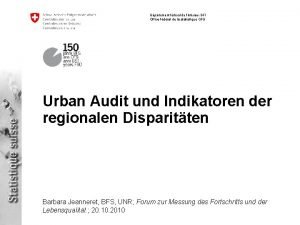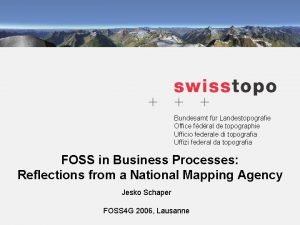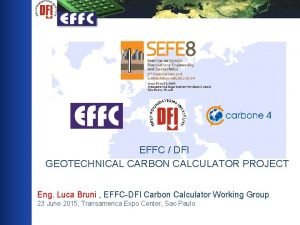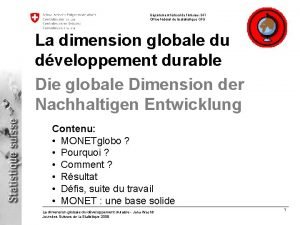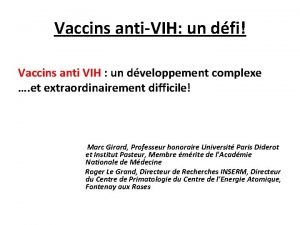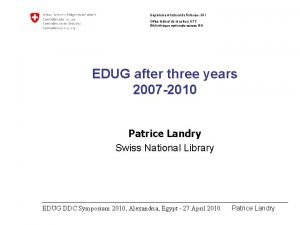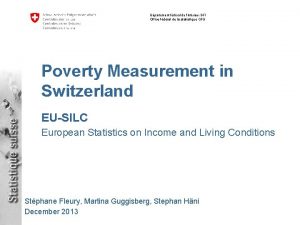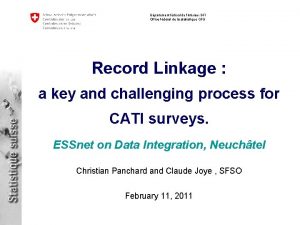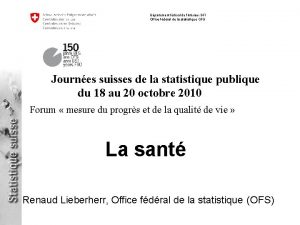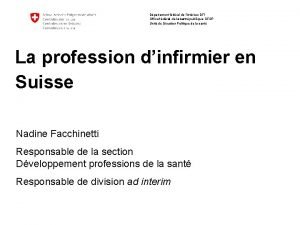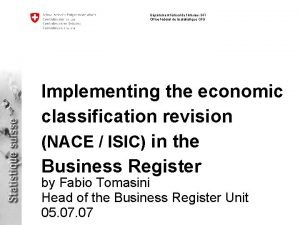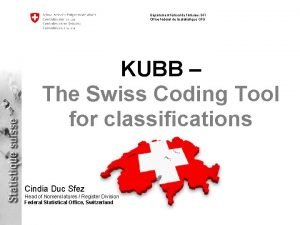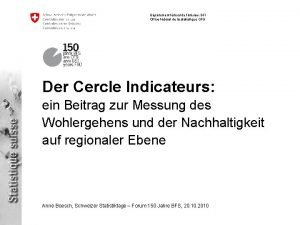Dpartement fdral de lintrieur DFI Office fdral de










- Slides: 10

Département fédéral de l‘intérieur DFI Office fédéral de météorologie et de climatologie Météo. Suisse Postprocessing methods Pierre Eckert Meteo. Swiss, Geneva COSMO WG 4 coordinator « Interpretation and applications » COSMO General meeting, September 2008

What postprocessing? • Derived fields: pressure levels, PV, radar reflectivity, … • Generation of products: TV, Internet, … • Diagnostics for aviation (upper air): turbulence, icing, … • Local adaptation, (downscaling? ) Meteo. Swiss – Posprocessing methods Pierre Eckert, Offenbach September 2009 2

Discussion points • How does postprocessing on global models compare to DMO from high resolution (HR) models? (must HR models be considered as expensive downscaling methods? ) • What postprocessing methods are suitable to be applied on high resolution models? (I think that postprocessing on HR models is not necessarily the same as postprocessing on global models) • Production of special parameters: fog, visibility, clouds base, … (aviation). • Which of these methods are already in use? • Definition of work packages Meteo. Swiss – Posprocessing methods Pierre Eckert, Offenbach September 2009 3

Perfect Prog, MOS Use two sets of historical data: 1. The predictand = the local element you want to predict: temperature at Langen, occurrence of fog at Frankfurt airport, … 2. The predictors = a bunch of model parameters: pressure, instability indices, 850 h. Pa temperature, winds, …It is allowed to take recent observations of the predicand as predictor. Correlations (regression discriminance) between the predictand the predictors are computed. Often the predictors are selected. Kalman filtering is probably a special case Meteo. Swiss – Posprocessing methods Pierre Eckert, Offenbach September 2009 4

Non linear methods • • The same data sets can be treated with non linear methods Neural networks Boosting … • Instead of defining hyperplanes in the predictor space, arbitrary shapes can be found. The selection of predictors, the choice of an optimal separation surface and the computation of coefficients is called “learning” • Meteo. Swiss – Posprocessing methods Pierre Eckert, Offenbach September 2009 5

Classification • A set of fixed meteorological situations is defined. • Every country has several such classifications • They are usually correlated to sensible weather (in the situation 7 b, the sun is shining in 90% of the cases in Sion) Meteo. Swiss – Posprocessing methods Pierre Eckert, Offenbach September 2009 6

Classification and interpretation Lugano rain > 1 mm/24 h Meteo. Swiss – Posprocessing methods Pierre Eckert, Offenbach September 2009 Lugano rain > 10 mm/24 h % 7

Analogs • This method looks for the n situations in the past which are closest to a given forecast according to some distance. • A statistics on the weather elements corresponding to these n situations is then made. • As with the classifier, it is possible that the closest situation is far away from the presented situation. Meteo. Swiss – Posprocessing methods Pierre Eckert, Offenbach September 2009 8

1 d, 2 d models • It is also possible to feed 1 d or 2 d models forced by the 3 d (4 d) model. • Ex. Fog model: soil model, a lot of levels in the few 10’s of meters of the atmosphere, aerosols, … • Should ideally be incorporated into the full model, but can be expensive. Meteo. Swiss – Posprocessing methods Pierre Eckert, Offenbach September 2009 9

Discussion points • How does postprocessing on global models compare to DMO from high resolution (HR) models? • What postprocessing methods are suitable to be applied on high resolution models? • Production of special parameters: fog, visibility, clouds base, … (aviation). • Which of these methods are already in use? • Definition of work packages Meteo. Swiss – Posprocessing methods Pierre Eckert, Offenbach September 2009 10
